Navigating an LU Schema
When creating or editing a Logical Unit schema the following options are used to navigate, configure and display information:
- Diagram Outline tab, a representation of the LU schema table’s list.
- Navigation pane, an overview of the LU schema located in the right corner of the working area.
- LU working area, where view options can be set.
Click for more information about the Diagram Outline and Toolbars.
How Do I Use the Diagram Outline?
The Diagram Outline displays an overview of the LU structure and can be used to search for a subset of tables included in the Schema.

To search for an LU table in an LU schema:
- Open the LU Schema window.
- Click the Diagram Outline tab in the right panel.
- In the Search field, type the name of the table or column and then click it in the displayed list. The table or column is highlighted with a green border.
What is the Navigation Pane?
The Navigation pane in the right corner of an LU schema is used to move between the different areas of a Schema. This is useful when looking at large Logical Units with many tables or hierarchy levels.
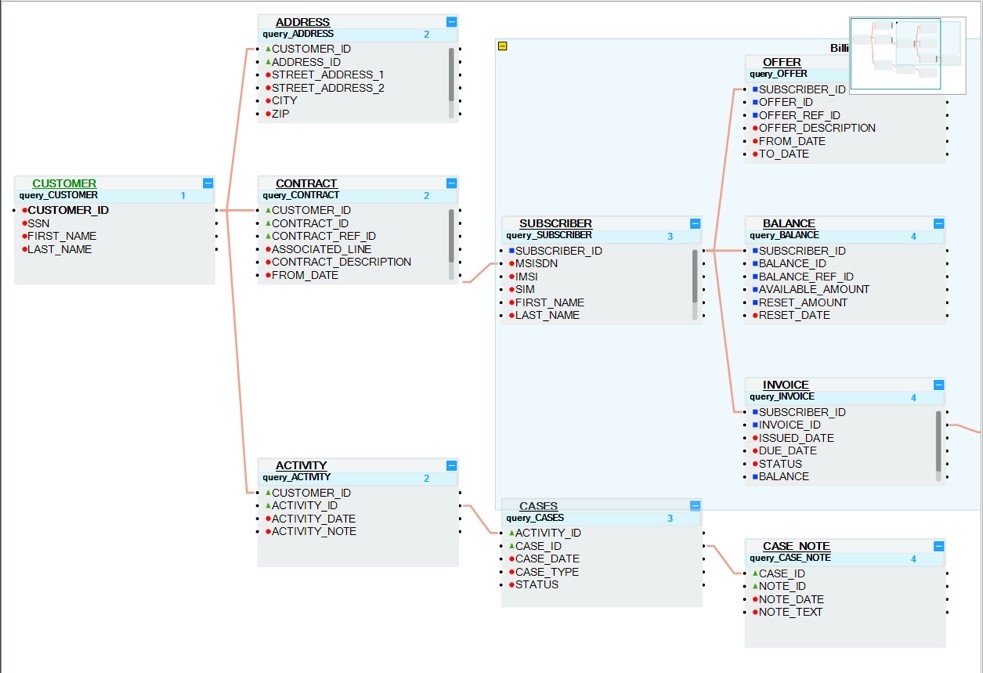
To hide the Navigation Pane use the context menu and uncheck the Show Overview Control. Studio lets you to reveal it back when needed via the context menu on the Working Area.
What are the LU Working Area View Options?
LU Tables relationship options:\ In the LU working area, right click an LU table object to display a context menu with the following actions:
|
set as: root |
Sets the table object as the root of this LU. |
|
show only Predecessor nodes |
Shows only objects and links that are predecessors of this object / field. |
|
show only successor nodes |
Shows only objects and links that are successors of this object / field. |
|
show only connected nodes |
Shows all objects and links connected to this object / field. |
|
show all nodes |
Shows all objects and links in this table. |
|
clear input links |
Clears all input links from objects in the Schema. |
|
clear output links |
Clears all output links from this LU table to its children Table Populations. |
|
clear all links |
Clears all input and output links in the LU tables. |
|
show data |
When clicked, a Query Builder window opens automatically in the newest LU file. |
For Example
Taking the CONTRACT table from the CUSTOMER LU as an example, the following illustrates key table relationship view options:
Show only predecessor nodes
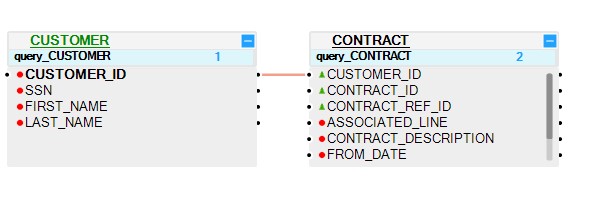
Show only successor nodes
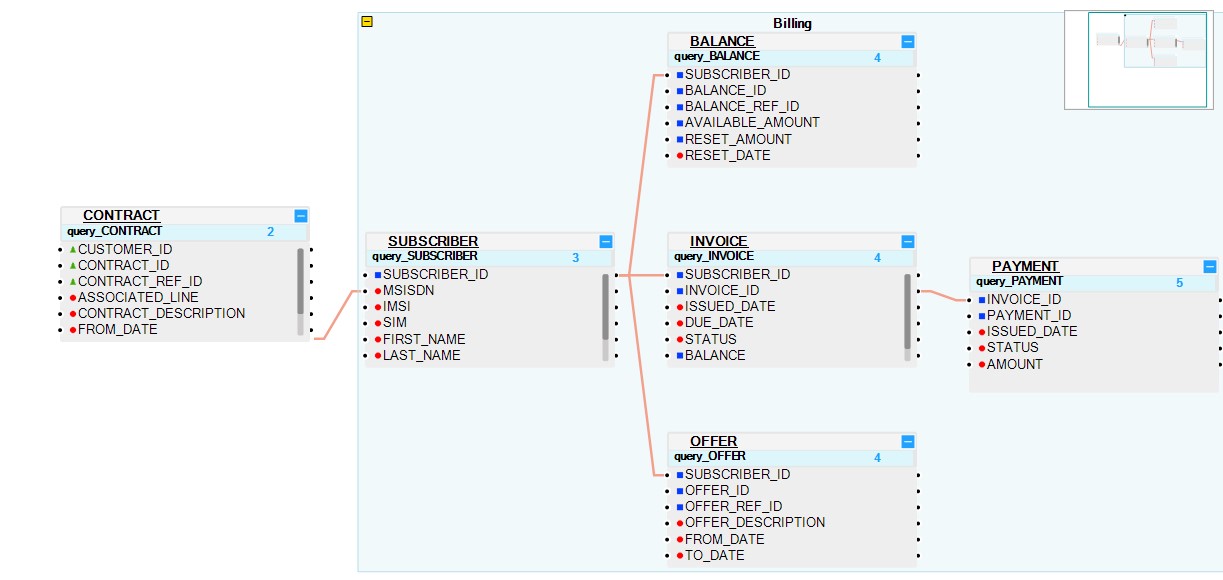
Show only connected nodes
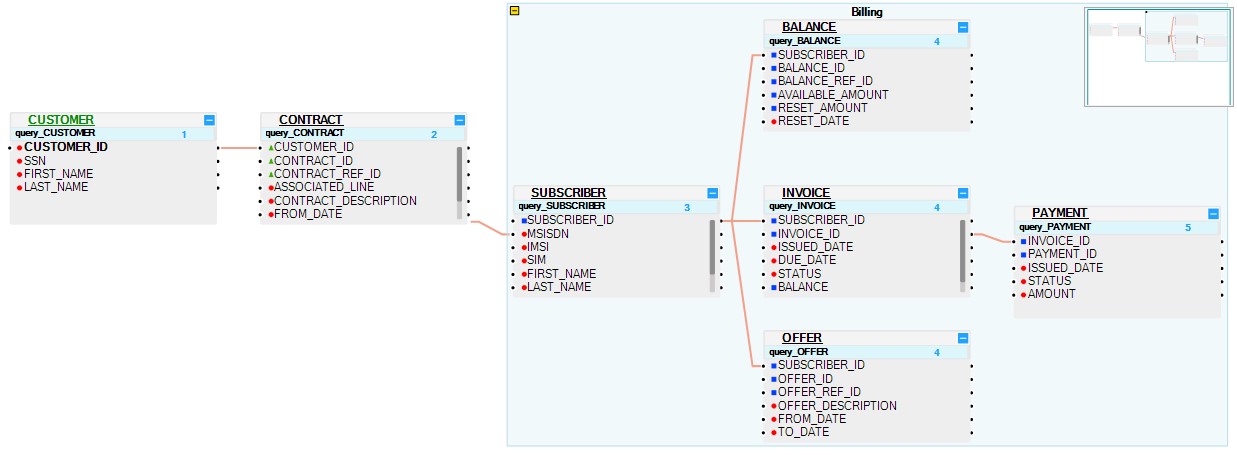
Display Options
In the LU working area right click anywhere to display a context menu with the following actions:
When creating or editing a Logical Unit/Data Product schema the following options are used to navigate, configure and display information:
- Logical Unit/Data Product table list from the explorer tree
- Logical Unit/Data Product schema.
- Logical Unit/Data Product tabs.
- Logical Unit/Data Product toolbar.
Click for more information about the Schema, Tabs, and Toolbars.
How Do I Use the Table List?
From the project's explorer tree, expand Implemenation > Logical Units/Data Products > [Logical Unit/Data Product Name] > Tables
The explorer tree will show a list of tables and their populations that are in the Logical Unit/Data Product:
- Each table name is next to a <> icon
- Each population name is under the table to which it belongs, with the name of the table attached to the beginning of the population name.
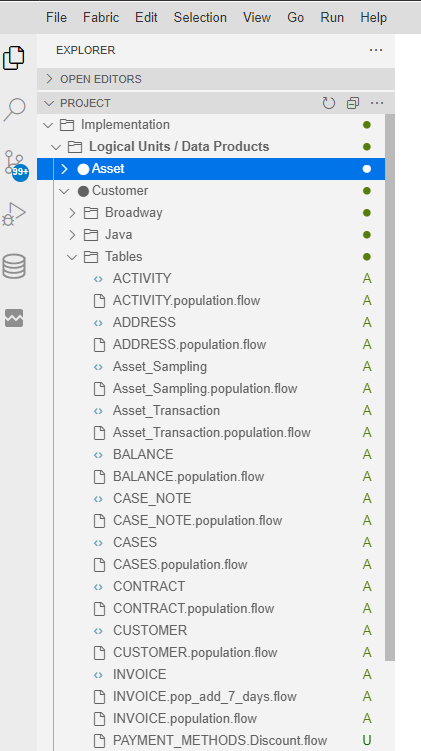
-- Click on a table name, and the table schema editor for that table will appear in the right window.
-- Click on a population name, and a Broadway flow diagram will appear in the right window.
How Do I Use the Logical Unit/Data Product Schema (diagram outline)?
From the project's explorer tree, expand Implemenation > Logical Units/Data Products > [Logical Unit/Data Product Name] > Schema
The Schema (diagram outline) displays an overview of the LU/DP structure and can be used to create or delete tables, group or ungroup tables, search for a subset of tables included in the Schema, and view the data included in those tables. For detailed instructions how to carry out these tasks, click here.
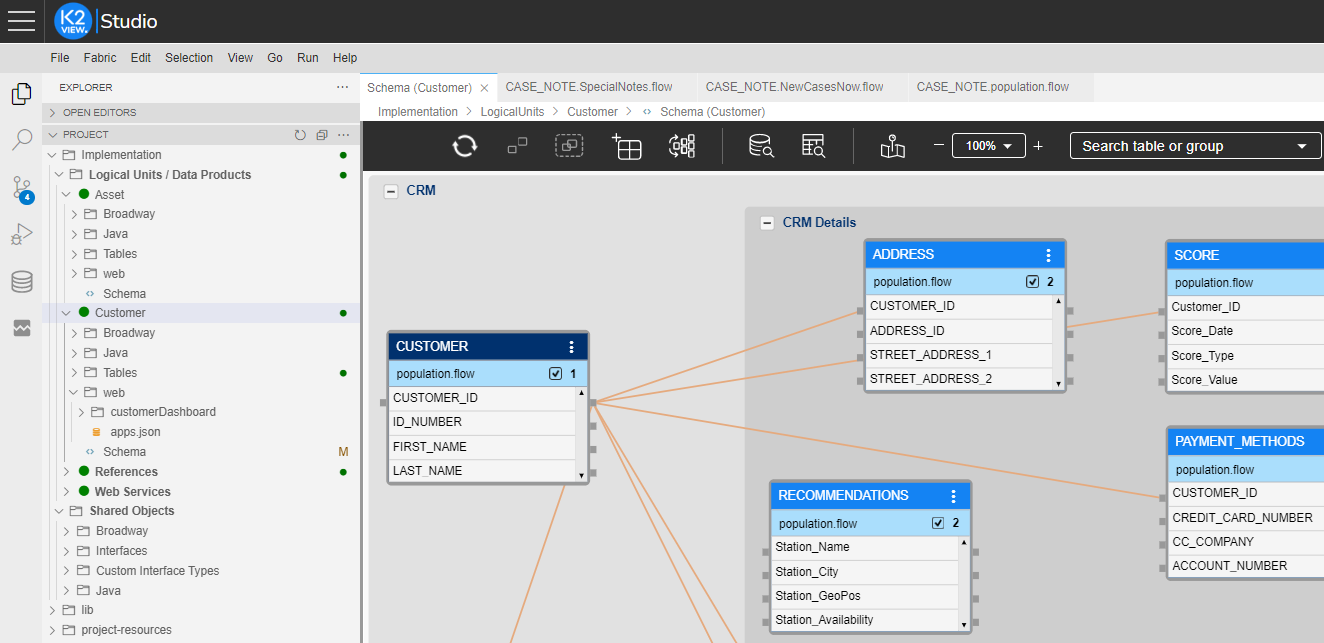
To search for a table using the diagram outline:
- Click the Search table or group pull-down menu from the toolbar on top of the diagram outline.

- Enter the name of the table, and choose the table you want from the list that appears. If the table you are looking for does not appear in the list, it either does not exist in the Schema, or you have made a spelling error.
- The table is highlighted with a blue outline.
To search for data in a table using the diagram outline, do one of the following:
- Click the Data Viewer icon in the toolbar (
), and the Data Viewer will open. You can use the Data Viewer to execute an SQL query to retrieve data from a table (you select the table from withing the Data Viewer).
- Click the Table Data Viewer icon in the toolbar (
), and the Table Data Viewer will appear in the lower window. You can use the Table Data Viewer to execute an SQL query to retrieve data from the selected table.
For detailed instructions on how to work with a Logical Unit/Data Product, click here
What is the Navigation Map?
The Navigation map is activated by clicking the navigation map icon in the tool bar ( 
This view can be used to move between the different areas of a Schema, and can be useful when looking at large Logical Units with many tables or hierarchy levels.
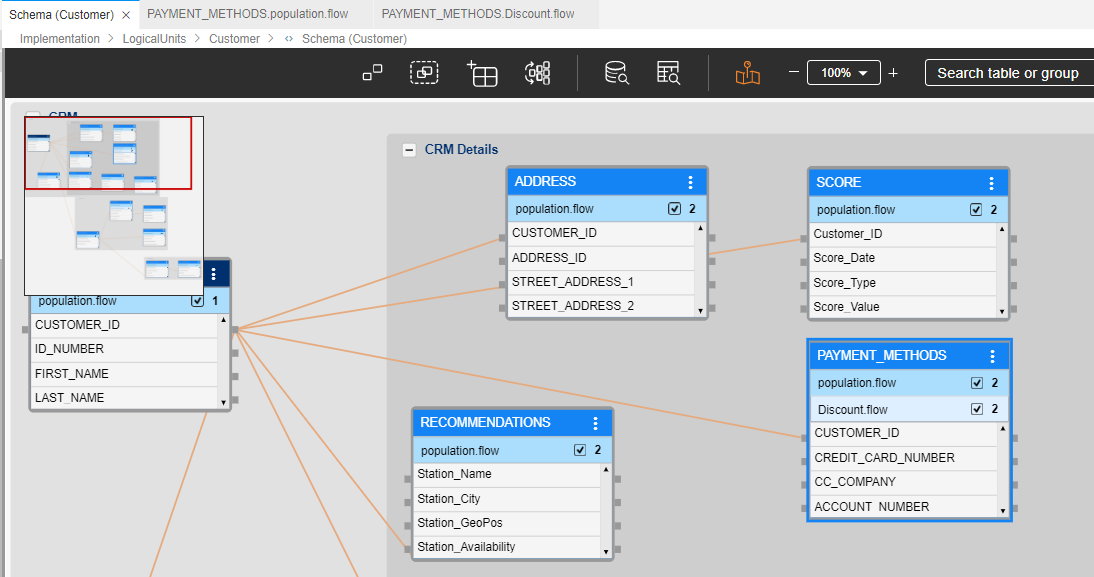
What is in the Properties pane?
The properties pane is accessed by clicking the arrow icon on the far right side of the diagram outline:
![]()
If you have selected a table, the properties pane for that table appears.
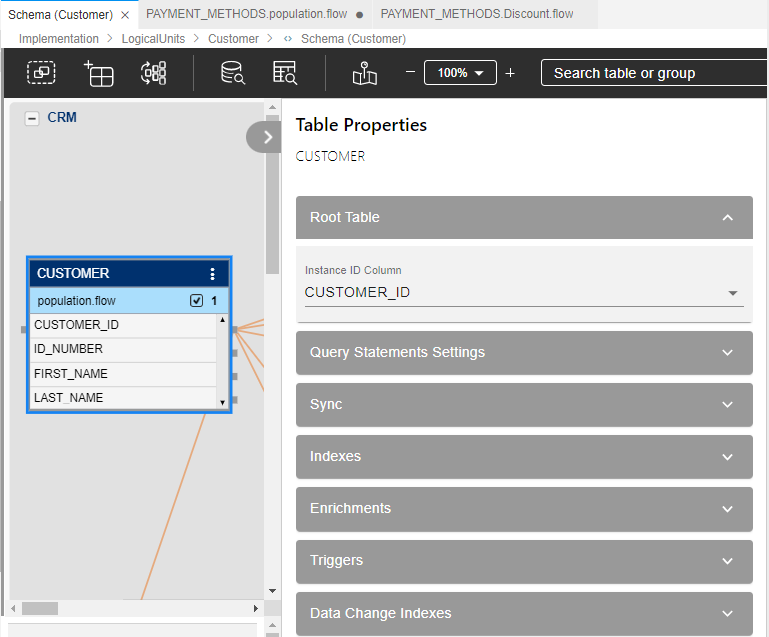
If you have not selected a table, the properties pane for the LU/DP Schema appears. You can tell that a table has not been selected, but the LU/DP has been selected when a blue frame forms around the LU/DP Schema.
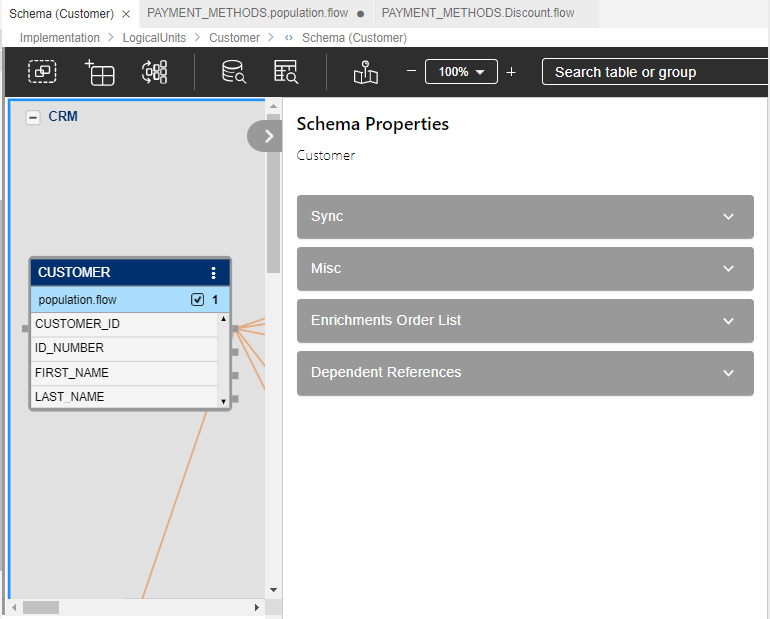
Navigating an LU Schema
When creating or editing a Logical Unit schema the following options are used to navigate, configure and display information:
- Diagram Outline tab, a representation of the LU schema table’s list.
- Navigation pane, an overview of the LU schema located in the right corner of the working area.
- LU working area, where view options can be set.
Click for more information about the Diagram Outline and Toolbars.
How Do I Use the Diagram Outline?
The Diagram Outline displays an overview of the LU structure and can be used to search for a subset of tables included in the Schema.

To search for an LU table in an LU schema:
- Open the LU Schema window.
- Click the Diagram Outline tab in the right panel.
- In the Search field, type the name of the table or column and then click it in the displayed list. The table or column is highlighted with a green border.
What is the Navigation Pane?
The Navigation pane in the right corner of an LU schema is used to move between the different areas of a Schema. This is useful when looking at large Logical Units with many tables or hierarchy levels.

To hide the Navigation Pane use the context menu and uncheck the Show Overview Control. Studio lets you to reveal it back when needed via the context menu on the Working Area.
What are the LU Working Area View Options?
LU Tables relationship options:\ In the LU working area, right click an LU table object to display a context menu with the following actions:
|
set as: root |
Sets the table object as the root of this LU. |
|
show only Predecessor nodes |
Shows only objects and links that are predecessors of this object / field. |
|
show only successor nodes |
Shows only objects and links that are successors of this object / field. |
|
show only connected nodes |
Shows all objects and links connected to this object / field. |
|
show all nodes |
Shows all objects and links in this table. |
|
clear input links |
Clears all input links from objects in the Schema. |
|
clear output links |
Clears all output links from this LU table to its children Table Populations. |
|
clear all links |
Clears all input and output links in the LU tables. |
|
show data |
When clicked, a Query Builder window opens automatically in the newest LU file. |
For Example
Taking the CONTRACT table from the CUSTOMER LU as an example, the following illustrates key table relationship view options:
Show only predecessor nodes

Show only successor nodes

Show only connected nodes

Display Options
In the LU working area right click anywhere to display a context menu with the following actions:
When creating or editing a Logical Unit/Data Product schema the following options are used to navigate, configure and display information:
- Logical Unit/Data Product table list from the explorer tree
- Logical Unit/Data Product schema.
- Logical Unit/Data Product tabs.
- Logical Unit/Data Product toolbar.
Click for more information about the Schema, Tabs, and Toolbars.
How Do I Use the Table List?
From the project's explorer tree, expand Implemenation > Logical Units/Data Products > [Logical Unit/Data Product Name] > Tables
The explorer tree will show a list of tables and their populations that are in the Logical Unit/Data Product:
- Each table name is next to a <> icon
- Each population name is under the table to which it belongs, with the name of the table attached to the beginning of the population name.

-- Click on a table name, and the table schema editor for that table will appear in the right window.
-- Click on a population name, and a Broadway flow diagram will appear in the right window.
How Do I Use the Logical Unit/Data Product Schema (diagram outline)?
From the project's explorer tree, expand Implemenation > Logical Units/Data Products > [Logical Unit/Data Product Name] > Schema
The Schema (diagram outline) displays an overview of the LU/DP structure and can be used to create or delete tables, group or ungroup tables, search for a subset of tables included in the Schema, and view the data included in those tables. For detailed instructions how to carry out these tasks, click here.

To search for a table using the diagram outline:
- Click the Search table or group pull-down menu from the toolbar on top of the diagram outline.

- Enter the name of the table, and choose the table you want from the list that appears. If the table you are looking for does not appear in the list, it either does not exist in the Schema, or you have made a spelling error.
- The table is highlighted with a blue outline.
To search for data in a table using the diagram outline, do one of the following:
- Click the Data Viewer icon in the toolbar (
), and the Data Viewer will open. You can use the Data Viewer to execute an SQL query to retrieve data from a table (you select the table from withing the Data Viewer).
- Click the Table Data Viewer icon in the toolbar (
), and the Table Data Viewer will appear in the lower window. You can use the Table Data Viewer to execute an SQL query to retrieve data from the selected table.
For detailed instructions on how to work with a Logical Unit/Data Product, click here
What is the Navigation Map?
The Navigation map is activated by clicking the navigation map icon in the tool bar ( 
This view can be used to move between the different areas of a Schema, and can be useful when looking at large Logical Units with many tables or hierarchy levels.

What is in the Properties pane?
The properties pane is accessed by clicking the arrow icon on the far right side of the diagram outline:
![]()
If you have selected a table, the properties pane for that table appears.

If you have not selected a table, the properties pane for the LU/DP Schema appears. You can tell that a table has not been selected, but the LU/DP has been selected when a blue frame forms around the LU/DP Schema.




